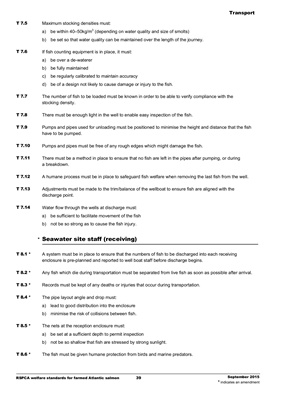
Transport
RSPCA welfare standards for farmed Atlantic salmon 39 September 2015
* indicates an amendment
T 7.5 Maximum stocking densities must:
a) be within 40-50kg/m
3 (depending on water quality and size of smolts)
b) be set so that water quality can be maintained over the length of the journey.
T 7.6 If fish counting equipment is in place, it must:
a) be over a de-waterer
b) be fully maintained
c) be regularly calibrated to maintain accuracy
d) be of a design not likely to cause damage or injury to the fish.
T 7.7 The number of fish to be loaded must be known in order to be able to verify compliance with the
stocking density.
T 7.8 There must be enough light in the well to enable easy inspection of the fish.
T 7.9 Pumps and pipes used for unloading must be positioned to minimise the height and distance that the fish
have to be pumped.
T 7.10 Pumps and pipes must be free of any rough edges which might damage the fish.
T 7.11 There must be a method in place to ensure that no fish are left in the pipes after pumping, or during
a breakdown.
T 7.12 A humane process must be in place to safeguard fish welfare when removing the last fish from the well.
T 7.13 Adjustments must be made to the trim/balance of the wellboat to ensure fish are aligned with the
discharge point.
T 7.14 Water flow through the wells at discharge must:
a) be sufficient to facilitate movement of the fish
b) not be so strong as to cause the fish injury.
* Seawater site staff (receiving)
T 8.1 * A system must be in place to ensure that the numbers of fish to be discharged into each receiving
enclosure is pre-planned and reported to well boat staff before discharge begins.
T 8.2 * Any fish which die during transportation must be separated from live fish as soon as possible after arrival.
T 8.3 * Records must be kept of any deaths or injuries that occur during transportation.
T 8.4 * The pipe layout angle and drop must:
a) lead to good distribution into the enclosure
b) minimise the risk of collisions between fish.
T 8.5 * The nets at the reception enclosure must:
a) be set at a sufficient depth to permit inspection
b) not be so shallow that fish are stressed by strong sunlight.
T 8.6 * The fish must be given humane protection from birds and marine predators.